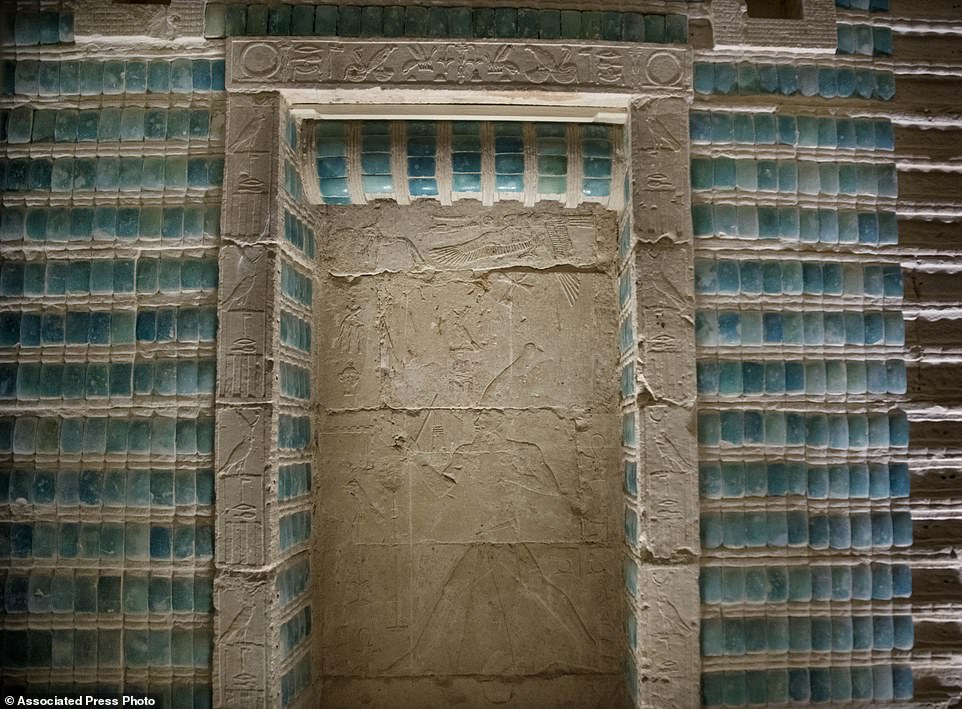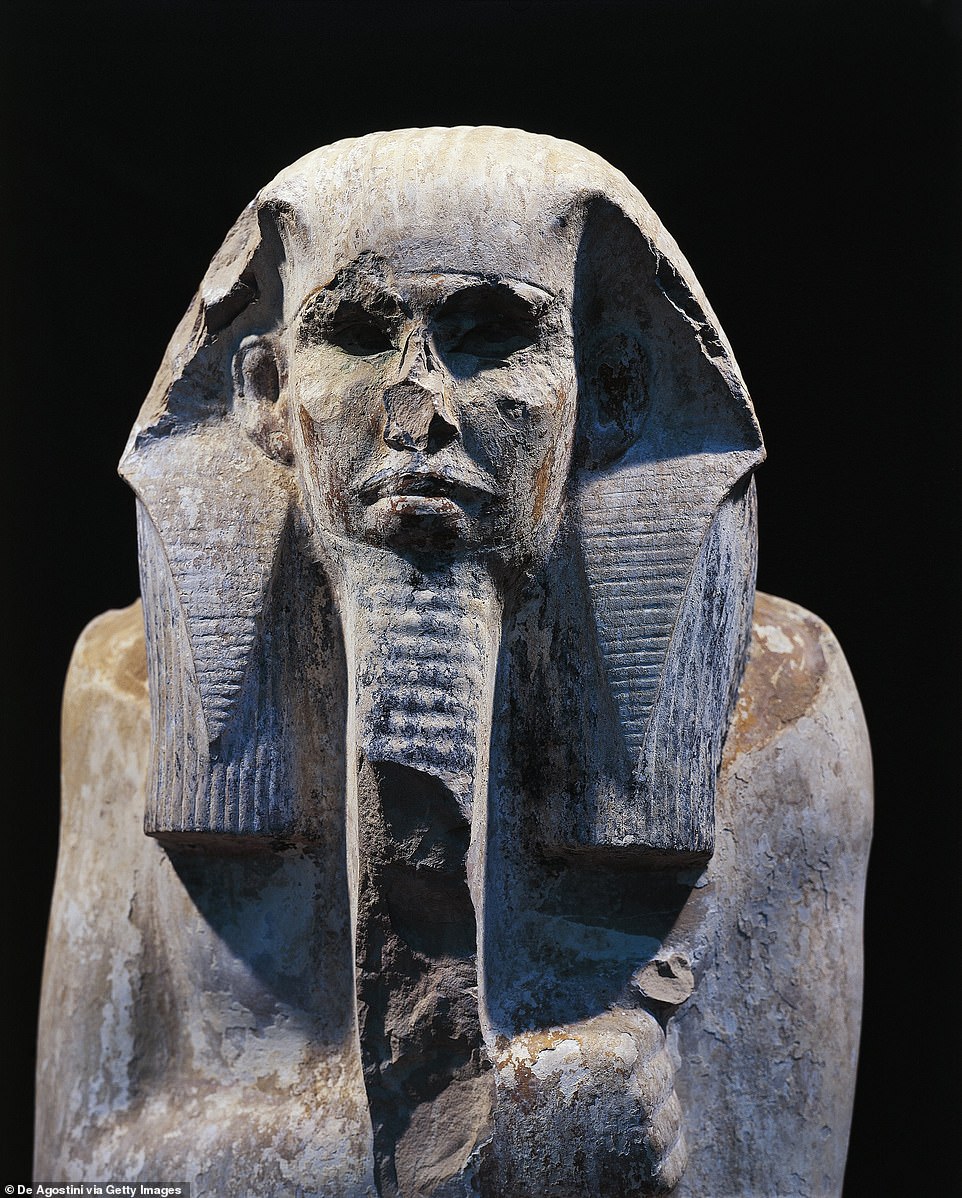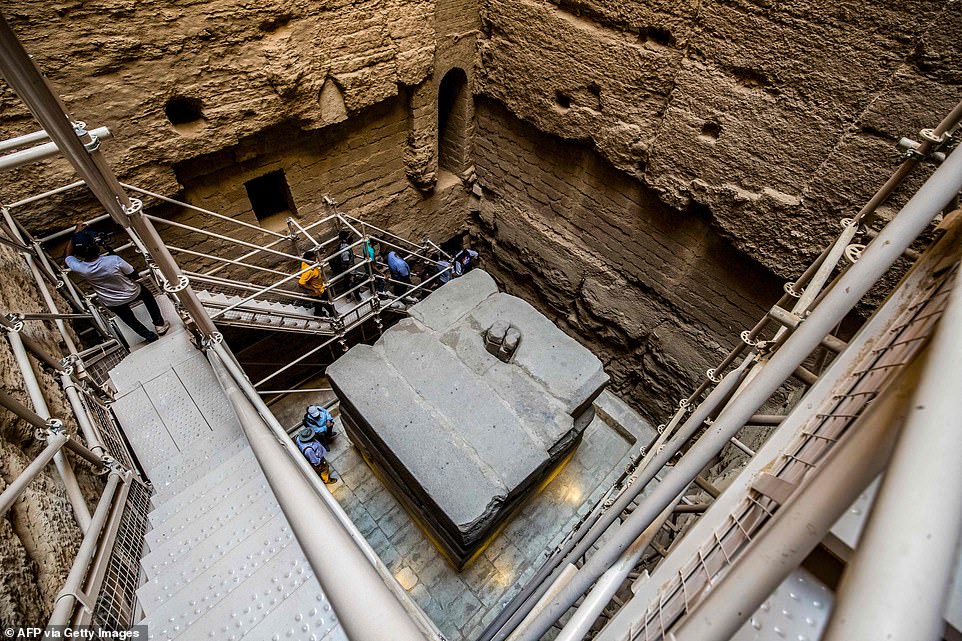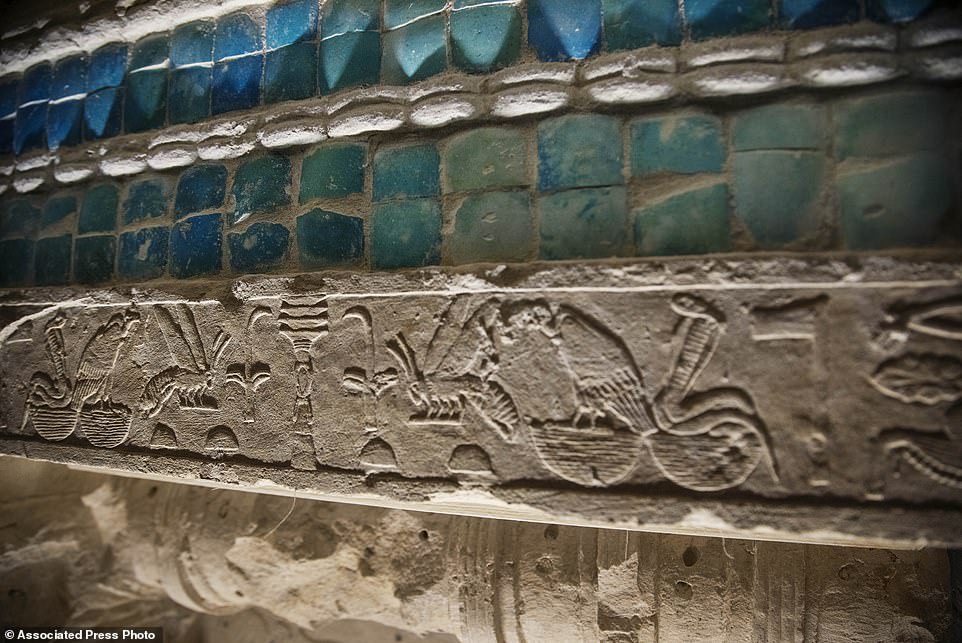The elaborate tomb of King Djoser, a pharaoh who lived more than 4,500 years ago in ancient Egypt, has been opened to the public following 15 years of extensive restorations.
The structure – known as the South Tomb – is largely underground and includes a labyrinth of corridors, decorated with hieroglyphic carvings and tiles.
However, the pharaoh was not buried in the South tomb, but was laid to rest in the famed Step Pyramid nearby, which was built by his personal architect Imhotep.
The South tomb, built between 2667 BC and 2648 BC, is thought to have been constructed for symbolic reasons, or perhaps to hold Djoser’s internal organs, said Mostafa Waziri, secretary-general of Egypt’s Supreme Council of Antiquities.
Scroll down for video

The structure – known as the South Tomb – is largely underground and includes a labyrinth of corridors, decorated with hieroglyphic carvings and tiles
The two structures make up part of the Saqqara complex near Cairo – one of the country´s richest archeological sites.
The Step Pyramid is the oldest known pyramid and one of the first examples of monumental architecture from the ancient world, according to UNESCO.
And the massive structure is believed to have been the inspiration for the Pyramids at Giza.
The South tomb, however, features stunning turquoise stones lining the inside walls that also feature intricate carvings.

Kin Djoser, who ruled for about 19 years, is know for his use of stone architecture, which can be seen in the South tomb, along with the Step Pyramid and ancient ruins in Memphis – the capital city southwest of what is now Cairo

The South tomb, built between 2667 BC and 2648 BC. Pictured is a path leading to the opening of the massive tomb

The opening leads to a stairway that descends about 98 feet below the surface and leads to the burial shaft (pictured)and then to the labyrinth of corridors
A large structure sits above the desert landscape, in which visitors walk through to enter the tomb.
The opening leads to a stairway that descends about 98 feet below the surface and leads to the burial shaft and then to the labyrinth of corridors.
However, the burial vault, according to experts, is too small to hold adult human remains, revealing the tomb was never built as King Djoser’s resting place.

The South tomb is thought to have been constructed for symbolic reasons, or perhaps to hold Djoser’s internal organs

Kin Djoser, which ruled for about 19 years, is know for his use of stone architecture, which can be seen in the South tomb, along with the Step Pyramid and ancient ruins in Memphis – the capital city southwest of what is now Cairo
Kin Djoser, who ruled for about 19 years, is know for his use of stone architecture, which can be seen in the South tomb, along with the Step Pyramid and ancient ruins in Memphis – the capital city southwest of what is now Cairo.
The South tomb was crumbling due to neglect, fierce desert winds, and eventually damaged by an earthquake that hit the area in 1992.
Egypt’s Ministry of Antiquities and Tourism said the opening of the South Tomb marked the completion of restoration work that started in 2006 and included reinforcing of the underground corridors, refurbishing the carvings and the tiled walls, along with installing lights throughout the once dark tunnels.
In addition to the South Tomb, the Saqqara plateau hosts at least 11 pyramids, including the Step Pyramid, as well as hundreds of tombs of ancient officials and other sites that range from the 1st Dynasty (2920 B.C.-2770 B.C.) to the Coptic period (395-642).

Pictured are just some of the intricate hieroglyphics that line the inner walls of the massive South tomb

Egypt’s Ministry of Antiquities and Tourism said the opening of the South Tomb marked the completion of restoration work that started in 2006 and included reinforcing of the underground corridors, refurbishing the carvings and the tiled walls, along with installing lights throughout the once dark tunnels

The inside of the tomb is designed like a labyrinth with corridors that and hallways throughout
The Saqqara site is part of the necropolis of Egypt´s ancient capital of Memphis that includes the famed Giza Pyramids, as well as smaller pyramids at Abu Sir, Dahshur and Abu Ruwaysh.
The ruins of Memphis were designated a UNESCO World Heritage site in 1970s.
Egypt has publicized a string of recent archaeological finds over the past year in an effort to revive its key tourism sector, which was badly hit by the turmoil that followed the 2011 uprising. The sector was also dealt a further blow by the global coronavirus pandemic.
The Step Pyramid, built around 4,700 years ago, measures 200ft high (60m) and is believed to be the first pyramid in Egypt and the oldest building in the world.

Egypt has publicized a string of recent archaeological finds over the past year in an effort to revive its key tourism sector, which was badly hit by the turmoil that followed the 2011 uprising. The sector was also dealt a further blow by the global coronavirus pandemic

The Step Pyramid (pictured), built around 4,700 years ago, measures 200ft high (60m) and is believed to be the first pyramid in Egypt and the oldest building in the world
It was built entirely out of stone by the ancient Egyptian architect Imhotep in the vast Saqqara necropolis south of Cairo, and was believed to be the final resting place of King Djoser, founder of the Old Kingdom.
Dosjer’s pyramid was a revolutionary concept, the pyramid prototype providing the blueprint for all future Egyptian developments, including the three that stand beside the Sphinx at Giza 12 miles to the northwest.
The step pyramid is made up of six mastabas (rectangular structures) stacked on top of each other.
Dating to 2,680 BC, the Djoser pyramid was designed and built under the direction of Imhotep, described by some as the world’s first architect and Djoser’s vizier.
The Step Pyramid had its own series of extensive renovations and reopened to the public in March 2020.
The Step Pyramid: Famed structure built more than 4,7000 years ago is believed to be the first ever pyramid built by ancient Egyptians
The step pyramid of Djoser measures almost 200ft high (60m) and is believed to be the first pyramid in Egypt and the oldest building in the world.
It was built entirely out of stone by Imhotep in the vast Saqqara necropolis south of Cairo to be the final resting place of King Djoser, founder of the Old Kingdom from the third dynasty.
Dating to 2,680 BC, the Djoser pyramid was a prototype providing the blueprint for all future Egyptian developments.
The step pyramid is made up of six mastabas (rectangular structures) stacked on top of each other.
Some scholars believer Djoser ruled Egypt for almost two decades.
It was hit by an earthquake in 1992 and restoration project started at the end of 2006 but slowed down after the revolution of 2011.
It resumed with vigor in 2013 and has now been reopened to the public.
The crumbling pyramid was shut in the 1930s over safety features.
Advertisement
Source link : https://www.dailymail.co.uk/sciencetech/article-9989597/Egypt-opens-ancient-tomb-King-Djoser-restoration.html












